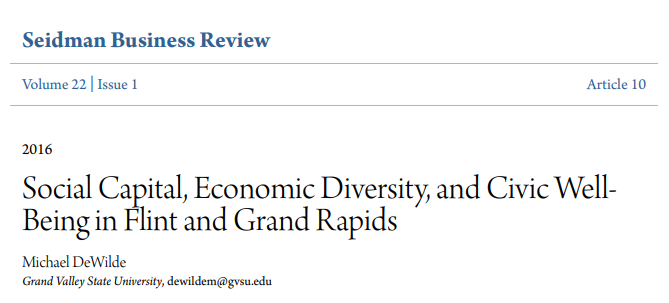News
An Introduction to Social Capital
April 19, 2016

Grand Rapids has, especially recently, a lot to boast about. If you enjoy art, commerce, beer, new restaurants, raising a family, beer, winter, new career opportunities, health care, beer, and, well, beer, it has a lot to recommend it. I’ve been here since 1994 and have been a beneficiary of the city’s growth and maturation. A couple of years ago I got curious about the city in ways only an academic can, and that was to take a look at it through its “social capital,” that is, all of the informal social networks (friends, colleagues, family, partners, fellow board members, etc.) that help determine the levels of trust and aid that are available to the people of a given city or region. If a place is high in social capital its people tend to fare better in terms of education, income and health, to mention but a few measures of individual and civic well-being.
As a result of that curiosity we published, in January of this year, a (mostly) well-received article titled “Social Capital, Economic Diversity, and Civic Well-Being in Flint and Grand Rapids.”
It was inspired by a seventy-year old study written by influential American sociologist C. Wright Mills and sought to respond to the question of what it is that makes a city or region a “good” place to live. There is little doubt that Grand Rapids qualifies as “good” by most measures, and, as noted above, it’s being increasingly recognized as such. Our research certainly backs up the claim that social and financial capital is available here in abundance. But, like so many other places in the US, mostly available if you are in the majority population. We’re finding that Blacks and Hispanics are making only iffy progress over the past decades as measured by educational attainment, per capita income, business ownership, and so on, especially as compared to whites. So spurred on by our original study we’ve spent the past four months focusing our efforts on understanding the Granville Corridor area, a part of the city home to Hispanic ethnicities from all parts of Mexico, Central and South America. What’s their conception of America Dream and how are they realizing it, if they are? Will they come to play a larger role in the “civic well-being” of Grand Rapids? What paths are open to them, and which ones do they choose? What is similar and what is different about their experiences compared to the Poles, Dutch, Germans and others who came before them? Our report will examine these and other questions. Once that report is out we plan to follow up with a closer look at some of the same questions relative to Grand Rapids’ black communities.

